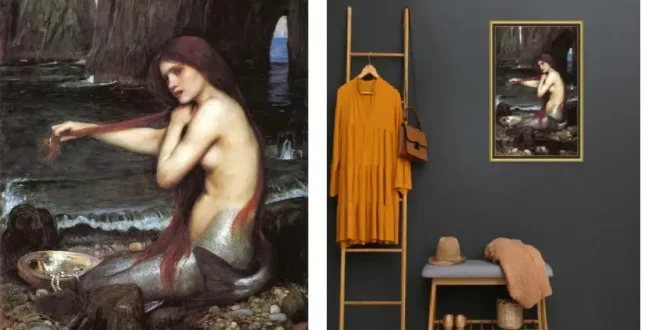The allure of mermaids, those mythical beings that dwell in the boundary between the human and aquatic realms, has captivated human imagination for centuries. These creatures, often depicted with the upper body of a human and the tail of a fish, embody the mysteries of the ocean and the untamed beauty of nature. Mermaids have been a subject of fascination across various cultures, each imbuing them with unique characteristics and stories. From the ancient Assyrian legend of Atargatis to the enchanting sirens of Greek mythology, mermaids have been both revered and feared, seen as omens of both good fortune and impending doom.
Interestingly, mermaids have not only thrived in folklore but have also made significant appearances in historical accounts. Seafarers of the past, including the famous explorer Christopher Columbus, have reported sightings of these elusive beings during their voyages. Such accounts, often blending the line between reality and myth, further fueled the intrigue surrounding mermaids. The scientific community has posited that these sightings were likely misidentifications of marine animals such as manatees or dugongs, creatures that could seem mermaid-like to the imaginative observer.
Mermaids have also been symbols of unfettered freedom and the untamable forces of nature. Their dual nature, bridging the human world with the mysterious depths of the ocean, resonates with the human fascination with exploration and the unknown. In many cultures, mermaids represent the embodiment of female power and mystique, often holding sway over the hearts and minds of sailors and kings alike, leading them into temptation or guiding them to safety.
The representation of mermaids in literature further highlights their multifaceted nature. From the seductive sirens in Homer’s “Odyssey” to the tragic figure of Hans Christian Andersen’s “The Little Mermaid,” these beings have served as potent symbols of desire, transformation, and the search for the soul. Andersen’s tale, in particular, has had a profound impact, inspiring countless adaptations in theater, film, and television, each exploring themes of love, sacrifice, and identity through the lens of the mermaid’s quest for humanity.
In the realm of art, mermaids have been a popular subject, captivating artists with their ethereal beauty and symbolic complexity. Their depiction varies greatly across different cultures and artistic movements, reflecting the artists’ fascination with these beings as symbols of both beauty and danger. The seductive allure of mermaids has been immortalized in countless paintings, sculptures, and decorative arts, each work offering a glimpse into the mermaid’s enchanting world. To buy mermaid painting is to invite the allure and mystery of the ocean into one’s own space, embracing the mermaid’s dual nature as both a serene and tumultuous force.
The influence of mermaids in art extends beyond traditional mediums. In modern and contemporary art, mermaids continue to inspire artists to explore themes of hybridity, identity, and the relationship between humanity and nature. From surrealistic interpretations to abstract representations, the mermaid motif challenges artists and viewers alike to reconsider boundaries and the possibilities of transformation. Those looking to buy mermaid paintings today will find themselves faced with a diverse array of artworks, each offering a unique perspective on the mermaid myth and its enduring appeal.
Mermaids have also left an indelible mark on the world of fashion. Designers have drawn inspiration from the mermaid’s form and mystique, creating garments that echo the fluidity and grace of these mythical beings. The mermaid silhouette, with its fitted bodice and flared bottom, has become a staple in bridal and evening wear, symbolizing elegance and allure.
In film and television, mermaids have been depicted in a multitude of ways, from the heartwarming and comedic to the dark and mysterious. The 1989 Disney animated film “The Little Mermaid” brought mermaids into the mainstream, endearing these mythical creatures to a new generation. Since then, mermaids have been featured in numerous movies and TV shows, each adaptation adding layers to the mermaid mythos and highlighting different aspects of their legend.
Music, too, has been touched by the magic of mermaids. Numerous songs and compositions have been inspired by mermaid tales, weaving the haunting beauty and melancholy of the mermaid’s world into melodies and lyrics. From classical compositions to modern pop songs, the theme of mermaids offers a rich vein of inspiration for musicians seeking to capture the essence of these elusive beings.
In folklore and mythology, mermaids have often been associated with magical abilities, including the power to heal, prophesy, and offer protection. These attributes have made mermaids central figures in rituals and ceremonies in various cultures, where they are invoked for their benevolent powers or appeased to avoid their wrath.
The environmental movement has also adopted the mermaid as a symbol of ocean conservation. The image of the mermaid, intertwined with the fate of the sea, serves as a poignant reminder of the need to protect our oceans and the life they harbor. Campaigns and initiatives often feature mermaids to highlight the connection between human actions and the health of the marine ecosystem.
In the digital age, mermaids have found new life on social media and online communities. Enthusiasts share artwork, stories, and experiences related to mermaids, fostering a global community united by a shared love for these mythical creatures. This digital renaissance has led to the emergence of “mermaiding” as a hobby and profession, with individuals donning mermaid tails to swim, perform, and raise awareness for oceanic causes.
The fascination with mermaids also reflects a deeper, universal yearning for connection and understanding between the human world and the natural realm. Through their lore and depiction in art and culture, mermaids serve as ambassadors of the ocean’s mysteries, reminding us of the beauty, power, and fragility of the natural world.
As we continue to explore the depths of our oceans and the limits of our imagination, the figure of the mermaid remains a potent symbol of curiosity, transformation, and the eternal bond between humanity and the sea. Their legacy, richly woven into the fabric of our cultural and artistic heritage, continues to inspire and enchant, a testament to the enduring allure of the mermaid myth.
In conclusion, mermaids are far more than just mythical creatures of the sea; they are symbols of mystery, beauty, and the interconnection between all living beings. Their influence in art, literature, and culture serves as a reminder of our fascination with the unknown and our desire to understand and become part of a world beyond our own. Whether through the purchase of a mermaid painting or the simple act of sharing a mermaid tale, we keep the spirit of these enigmatic beings alive, allowing their stories to flow and evolve, much like the ever-changing sea.
Did you find this article helpful? Check out the rest of our blog.
 SlushWeb Bringing Facts to Light
SlushWeb Bringing Facts to Light



